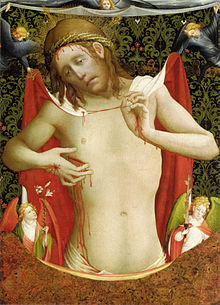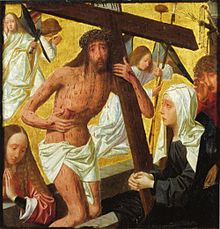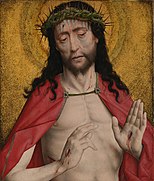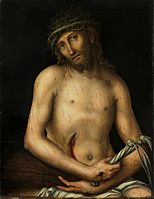
An icon is a religious work of art, most commonly a painting, in the cultures of the Eastern Orthodox, Oriental Orthodox, and Catholic churches. They are not simply artworks; "an icon is a sacred image used in religious devotion". The most common subjects include Jesus, Mary, saints, and angels. Although especially associated with portrait-style images concentrating on one or two main figures, the term also covers most of the religious images in a variety of artistic media produced by Eastern Christianity, including narrative scenes, usually from the Bible or the lives of saints.
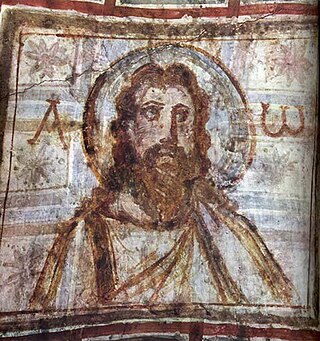
The depiction of Jesus in pictorial form dates back to early Christian art and architecture, as aniconism in Christianity was rejected within the ante-Nicene period. It took several centuries to reach a conventional standardized form for his physical appearance, which has subsequently remained largely stable since that time. Most images of Jesus have in common a number of traits which are now almost universally associated with Jesus, although variants are seen.

The Pietà is a subject in Christian art depicting the Blessed Virgin Mary cradling the dead body of Jesus Christ after his Descent from the Cross. It is most often found in sculpture. The Pietà is a specific form of the Lamentation of Christ in which Jesus is mourned by the Virgin Mary alone. However, in practice works called a Pietà may include angels, the other figures usual in Lamentations, and even donor portraits.

A doubting Thomas is a skeptic who refuses to believe without direct personal experience – a reference to the Gospel of John's depiction of the Apostle Thomas, who, in John's account, refused to believe the resurrected Jesus had appeared to the ten other apostles until he could see and feel Jesus's crucifixion wounds.

Ecce homo are the Latin words used by Pontius Pilate in the Vulgate translation of the Gospel of John, when he presents a scourged Jesus, bound and crowned with thorns, to a hostile crowd shortly before His crucifixion. The original New Testament Greek: "ἰδοὺ ὁ ἄνθρωπος", romanized: "idoù ho ánthropos", is rendered by most English Bible translations, e.g. the Douay-Rheims Bible and the King James Version, as "behold the man". The scene has been widely depicted in Christian art.
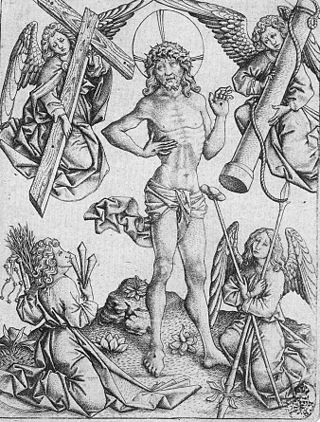
Arma Christi, or the Instruments of the Passion, are the objects associated with the Passion of Jesus Christ in Christian symbolism and art. They are seen as arms in the sense of heraldry, and also as the weapons Christ used to achieve his conquest over Satan. There is a group, at a maximum of about 20 items, which are frequently used in Christian art, especially in the Late Middle Ages. Typically they surround either a cross or a figure of Christ of the Man of Sorrows type, either placed around the composition, or held by angels.

The Descent from the Cross, or Deposition of Christ, is the scene, as depicted in art, from the Gospels' accounts of Joseph of Arimathea and Nicodemus taking Christ down from the cross after his crucifixion. In Byzantine art the topic became popular in the 9th century, and in the West from the 10th century. The Descent from the Cross is the 13th Station of the Cross, and is also the sixth of the Seven Sorrows of the Blessed Virgin Mary.
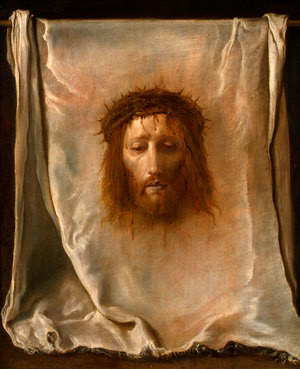
Andachtsbilder is a German term often used in English in art history for Christian devotional images designed as aids for prayer or contemplation. The images "generally show holy figures extracted from a narrative context to form a highly focused, and often very emotionally powerful, vignette".
The servant songs are four songs in the Book of Isaiah in the Hebrew Bible, which include Isaiah 42:1–4; Isaiah 49:1–6; Isaiah 50:4–11; and Isaiah 52:13–53:12. The songs are four poems written about a certain "servant of YHWH". Yahweh calls the servant to lead the nations, but the servant is horribly abused by them. In the end, he is rewarded.

The Epitaphios is a Christian religious icon, typically consisting of a large, embroidered and often richly adorned cloth, bearing an image of the dead body of Christ, often accompanied by his mother and other figures, following the Gospel account. It is used during the liturgical services of Holy Saturday in the Eastern Orthodox and Byzantine Catholic churches.

The Pensive Christ is a subject in Christian iconography depicting a contemplating Jesus, sitting with his head supported by his hand with the Crown of Thorns and marks of his flagellation. It is, therefore, a picture of Jesus shortly before his crucifixion, although more an andachtsbild or devotional subject than intended to show an actual moment in the narrative of the Passion of Christ. The Pensive Christ is much more common in sculpture than in painting, where the similar Man of Sorrows is more often depicted.

The Nativity of Jesus has been a major subject of Christian art since the 4th century.

The Seven Joys of the Virgin is a popular devotion to events of the life of the Virgin Mary, arising from a trope of medieval devotional literature and art.

The Lamentation of Christ is a very common subject in Christian art from the High Middle Ages to the Baroque. After Jesus was crucified, his body was removed from the cross and his friends mourned over his body. This event has been depicted by many different artists.

The life of Christ as a narrative cycle in Christian art comprises a number of different subjects showing events from the life of Jesus on Earth. They are distinguished from the many other subjects in art showing the eternal life of Christ, such as Christ in Majesty, and also many types of portrait or devotional subjects without a narrative element.

The Mass of Saint Gregory is a subject in Roman Catholic art which first appears in the late Middle Ages and was still found in the Counter-Reformation. Pope Gregory I is shown saying Mass just as a vision of Christ as the Man of Sorrows has appeared on the altar in front of him, in response to the Pope's prayers for a sign to convince a doubter of the doctrine of transubstantiation.

The Transfiguration of Jesus has been an important subject in Christian art, above all in the Eastern church, some of whose most striking icons show the scene.

Man of Sorrows is a small Early Netherlandish oil on wood panel painting completed c. 1485–1495. It is attributed to Geertgen tot Sint Jans and in the tradition of the devotional images of the "Man of Sorrows", which typically show Christ before his crucifixion, naked above the waist, bearing the wounds of his Passion. The panel has an unusually complex and suffocating spatial design, and depicts the mocking of Jesus, and his grieving mother. The panel is steeped in both complex iconography and deep pathos. Christ is in obvious pain and holds his wounds up for the viewer. He looks out while white robed weeping angels bear the Arma Christi -objects associated with his crucifixion and death- float around him. The attending saints include Mary and the Magdalene.

The Trinity is most commonly seen in Christian art with the Holy Spirit represented by a dove, as specified in the gospel accounts of the baptism of Christ; he is nearly always shown with wings outspread. However depictions using three anthropomorphic figures appear occasionally in most periods of art.
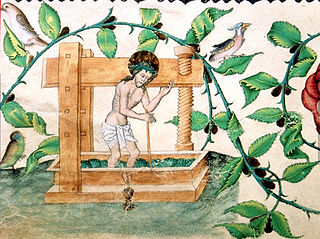
Christ in the winepress or the mystical winepress is a motif in Christian iconography showing Christ standing in a winepress, where Christ himself becomes the grapes in the press. It derives from the interpretation by Augustine and other early theologians of a group of passages in the Bible and is found as a visual image in Christian art between about 1100 and the 18th century, as well as in religious literature of many kinds. The image in art underwent a number of changes of emphasis, while remaining fairly consistent in its basic visual content, and was one of the relatively few medieval metaphorical or allegorical devotional images to maintain a foothold in Protestant iconography after the Reformation.
